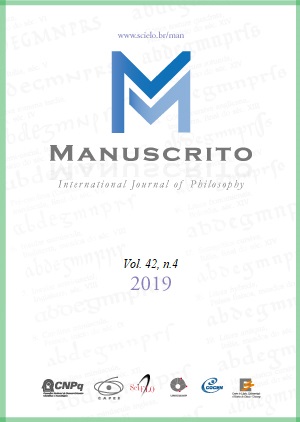Resumo
What lies behind Aristotle's declarations that an attribute or feature that is demonstrated to belong to a scientific subject is proper to that subject? The answer is found in APo. 2.8-10, if we understand these chapters as bearing not only on Aristotle theory of definition but also as clarifying the logical structure of demonstration in general. If we identify the basic subjects with what has no different cause, and demonstrable attributes (the kath 'hauta sumbebēkota) with what have' a different cause ', the definitions of demonstrable attributes necessarily have the minor terms of the appropriate demonstrations in their definitions , for which reason the subjects and demonstrable attributes are coextensive.
Referências
ANGIONI, L. “Aristotle on Necessary Principles and on Explaining X Through the Essence of X”. Studia Philosophica Estonica 7.2, p. 88-112, 2014.
ANGIONI, L. “Aristotle’s definition of scientific knowledge (APo 71b 9-12)”. Logical Analysis and History of Philosophy 19, pp. 79-105, 2016.
ANGIONI, L. “Causality and Coextensiveness in Aristotle’s Posterior Analytics 1.13”. Oxford Studies in Ancient Philososophy 54, pp. 159-85, 2018.
BARNES, J. Aristotle’s Posterior Analytics: Translated with a Commentary. Second edition. Oxford: Clarendon Press, 1994.
BRONSTEIN, D. Aristotle on Knowledge and Learning: The Posterior Analytics. Oxford: Oxford University Press, 2016.
CHARLES, D. Aristotle on Meaning and Essence. Oxford: Clarendon Press, 2000.
CHARLES, D. (ed.), Definition in Greek Philosophy. Oxford: Oxford University Press, 2010.
CHARLES, D. “Definition and Explanation in the Posterior Analytics and Metaphysics” in D. Charles (ed.), pp. 286-327, 2010.
CODE, A. “Aristotle: Essence and Accident”. In R. Grandy and R. Warner (eds.), pp. 411-439, 1986a.
CODE, A. “Aristotle's Investigation of a Basic Logical Principle: Which Science Investigates the Principle of NonContradiction?”. Canadian Journal of Philosophy 16.3. pp. 341-57, 1986b.
DE HAAS, F., LEUNISSEN, M., MARTIJN. M. (eds.), Interpreting Aristotle’s Posterior Analytics in Late Antiquity and Beyond. Leiden: Brill, 2010.
DESLAURIERS. M. Aristotle on Definition. Leiden: Brill, 2007.
FEREJOHN, M. Formal Causes: Definition, Explanation, and Primacy in Socratic and Aristotelian Thought. Oxford: Oxford University Press, 2013.
GOLDIN, O. Explaining an Eclipse: Aristotle’s Posterior Analytics 2.1-10. Ann Arbor: University of Michigan Press, 1996.
GOLDIN, O. “Atoms, complexes, and demonstration: Posterior Analytics 96b15–25”. Studies in History and Philosophy of Science 35, pp. 707–727, 2004.
GOLDIN, O. (tr.) Philoponus(?): On Aristotle, Posterior Analytics 2. London: Duckworth, 2009.
GOLDIN, O. “Two Traditions in the Ancient Posterior Analytics Commentaries”. In F. de Haas, M. Leunissen, and M. Martijn (eds.) 2010, pp. 155-82.
GRANDY, R. AND WARNER, R. (eds.), Philosophical Grounds of Rationality: Intentions, Categories, Oxford: Clarendon Press, 1986.
GRANGER, H. “The Differentia and the per se Accident in Aristotle”. Archiv für Geschichte der Philosophie 63, p. 118- 29, 1981. Owen Goldin 83 Manuscrito – Rev. Int. Fil. Campinas, v. 42, n. 4, pp. 44-84, Oct-Dec. 2019.
HARARI, O. Knowledge and Demonstration: Aristotle's Posterior Analytics. Dortrecht: Kluwer Academic Publishers, 2004.
INWOOD, B. “A Note on Commensurate Universals in the ‘Posterior Analytics’”. Phronesis 24.3, pp. 320-9, 1979.
LANDOR, B. “Definitions and Hypotheses in Posterior Analytics 72 a19-25 and 76 b 35-77a4”. Phronesis 26, pp. 308-18, 1981.
LANDOR, B. “Aristotle on Demonstrating Essence”. Apeiron 19.2. pp. 116-32, 1985.
LEWIS, F. Substance and Predication in Aristotle, Cambridge: Cambridge University Press, 1992.
MANSION, S. Le jugement d’existence chez Aristote. Second edition. Louvain: Publications Universitaires de Louvain, 1976.
MCKIRAHAN, R. Principles and Proofs: Aristotle’s Theory of Demonstrative Science. Princeton: Princeton University Press, 1992.
ROSS, W. D. Aristotle’s “Prior and Posterior Analytics”. Oxford: Clarendon Press, 1949.
RUSSELL, B. “The Philosophy of Logical Atomism”. The Monist 28, pp. 495-527, 1918.
TIERNEY, R. “Aristotle’s Scientific Demonstrations as Expositions of Essence”. Oxford Studies in Ancient Philosophy 20, pp. 149-70, 2001.
TILES, J., “Why the Triangle has 2 Right Angles Kath’ Hauto”. Phronesis 28, pp. 1-17, 1983.
WALLIES, M. (ed.). Commentaria in Aristotelem Graeca, XIII, Berlin: Reimer, 1909. Kath´ Hauta Predicates and the ´Commensurate Universals’ 84 Manuscrito – Rev. Int. Fil. Campinas, v. 42, n. 4, pp. 44-84, Oct-Dec. 2019.
ZUPPOLINI, B. “Aristotle’s Foundationalism”. Dissertatio 44, pp. 187-211, 2016.
ZUPPOLINI, B. “Aristotle on Per Se Accidents”. Ancient Philosophy 38, pp. 113-35, 2018.


